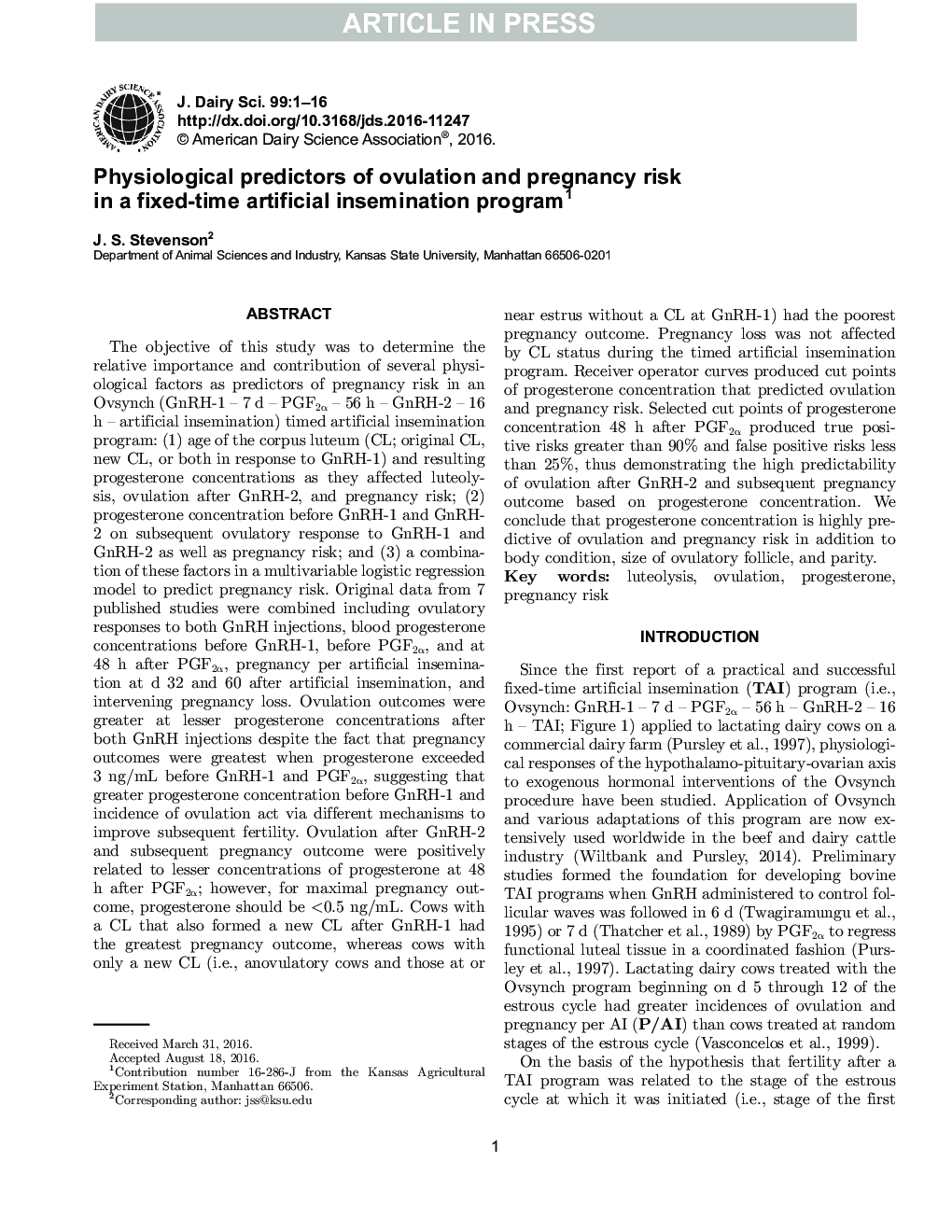| کد مقاله | کد نشریه | سال انتشار | مقاله انگلیسی | نسخه تمام متن |
|---|---|---|---|---|
| 5542778 | 1402522 | 2016 | 16 صفحه PDF | دانلود رایگان |
عنوان انگلیسی مقاله ISI
Physiological predictors of ovulation and pregnancy risk in a fixed-time artificial insemination program1
ترجمه فارسی عنوان
پیش بینی های فیزیولوژیکی از تخمک گذاری و ریسک حاملگی در برنامه تلقیح مصنوعی ثابت شده 1
دانلود مقاله + سفارش ترجمه
دانلود مقاله ISI انگلیسی
رایگان برای ایرانیان
کلمات کلیدی
لووتولیز، تخمک گذاری، پروژسترون، خطر حاملگی،
موضوعات مرتبط
علوم زیستی و بیوفناوری
علوم کشاورزی و بیولوژیک
علوم دامی و جانورشناسی
چکیده انگلیسی
The objective of this study was to determine the relative importance and contribution of several physiological factors as predictors of pregnancy risk in an Ovsynch (GnRH-1 - 7 d - PGF2α - 56 h - GnRH-2 - 16 h - artificial insemination) timed artificial insemination program: (1) age of the corpus luteum (CL; original CL, new CL, or both in response to GnRH-1) and resulting progesterone concentrations as they affected luteolysis, ovulation after GnRH-2, and pregnancy risk; (2) progesterone concentration before GnRH-1 and GnRH-2 on subsequent ovulatory response to GnRH-1 and GnRH-2 as well as pregnancy risk; and (3) a combination of these factors in a multivariable logistic regression model to predict pregnancy risk. Original data from 7 published studies were combined including ovulatory responses to both GnRH injections, blood progesterone concentrations before GnRH-1, before PGF2α, and at 48 h after PGF2α, pregnancy per artificial insemination at d 32 and 60 after artificial insemination, and intervening pregnancy loss. Ovulation outcomes were greater at lesser progesterone concentrations after both GnRH injections despite the fact that pregnancy outcomes were greatest when progesterone exceeded 3 ng/mL before GnRH-1 and PGF2α, suggesting that greater progesterone concentration before GnRH-1 and incidence of ovulation act via different mechanisms to improve subsequent fertility. Ovulation after GnRH-2 and subsequent pregnancy outcome were positively related to lesser concentrations of progesterone at 48 h after PGF2α; however, for maximal pregnancy outcome, progesterone should be <0.5 ng/mL. Cows with a CL that also formed a new CL after GnRH-1 had the greatest pregnancy outcome, whereas cows with only a new CL (i.e., anovulatory cows and those at or near estrus without a CL at GnRH-1) had the poorest pregnancy outcome. Pregnancy loss was not affected by CL status during the timed artificial insemination program. Receiver operator curves produced cut points of progesterone concentration that predicted ovulation and pregnancy risk. Selected cut points of progesterone concentration 48 h after PGF2α produced true positive risks greater than 90% and false positive risks less than 25%, thus demonstrating the high predictability of ovulation after GnRH-2 and subsequent pregnancy outcome based on progesterone concentration. We conclude that progesterone concentration is highly predictive of ovulation and pregnancy risk in addition to body condition, size of ovulatory follicle, and parity.
ناشر
Database: Elsevier - ScienceDirect (ساینس دایرکت)
Journal: Journal of Dairy Science - Volume 99, Issue 12, December 2016, Pages 10077-10092
Journal: Journal of Dairy Science - Volume 99, Issue 12, December 2016, Pages 10077-10092
نویسندگان
J.S. Stevenson,
